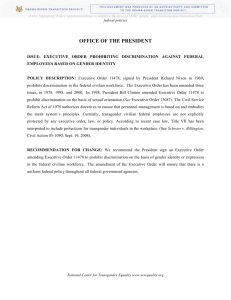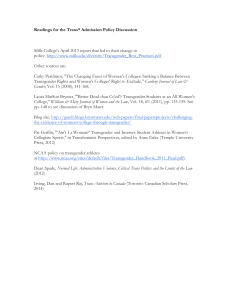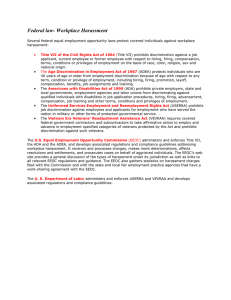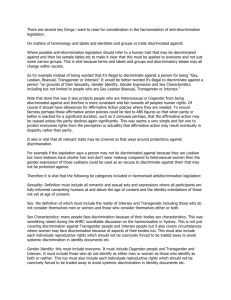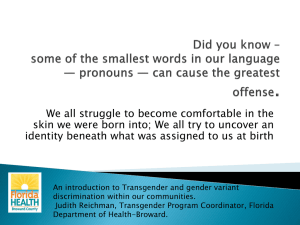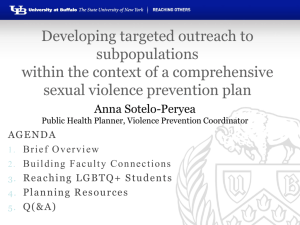EEOC Files Landmark Suits Challenging Transgender Discrimination Under Title VII
advertisement
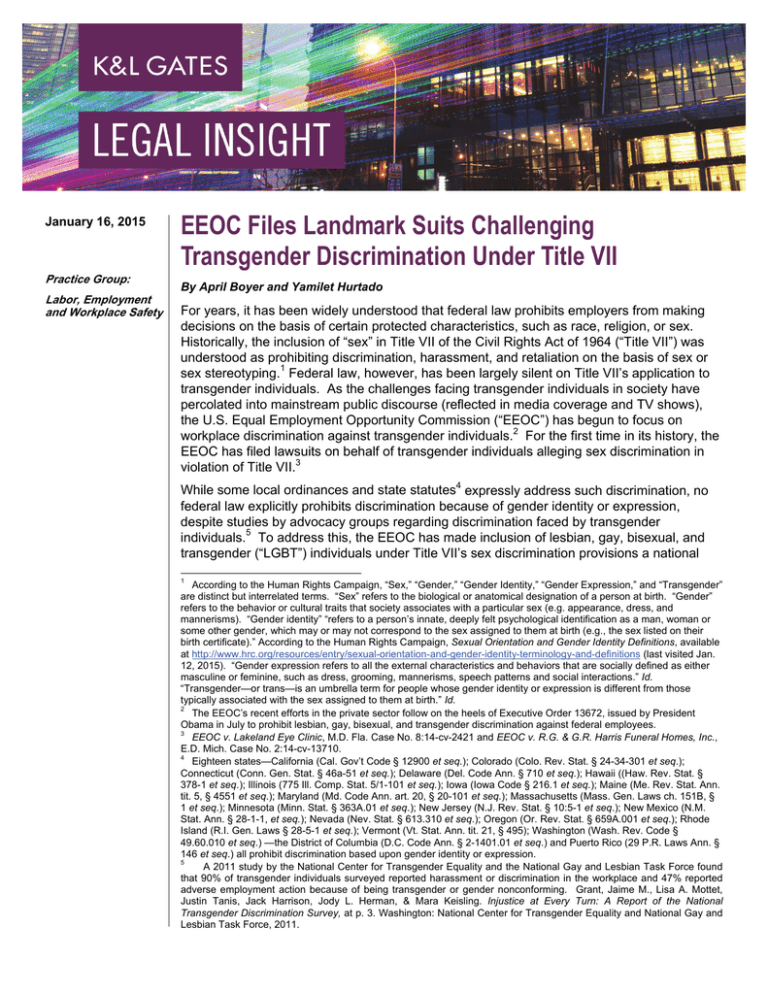
January 16, 2015 Practice Group: Labor, Employment and Workplace Safety EEOC Files Landmark Suits Challenging Transgender Discrimination Under Title VII By April Boyer and Yamilet Hurtado For years, it has been widely understood that federal law prohibits employers from making decisions on the basis of certain protected characteristics, such as race, religion, or sex. Historically, the inclusion of “sex” in Title VII of the Civil Rights Act of 1964 (“Title VII”) was understood as prohibiting discrimination, harassment, and retaliation on the basis of sex or sex stereotyping.1 Federal law, however, has been largely silent on Title VII’s application to transgender individuals. As the challenges facing transgender individuals in society have percolated into mainstream public discourse (reflected in media coverage and TV shows), the U.S. Equal Employment Opportunity Commission (“EEOC”) has begun to focus on workplace discrimination against transgender individuals.2 For the first time in its history, the EEOC has filed lawsuits on behalf of transgender individuals alleging sex discrimination in violation of Title VII.3 While some local ordinances and state statutes4 expressly address such discrimination, no federal law explicitly prohibits discrimination because of gender identity or expression, despite studies by advocacy groups regarding discrimination faced by transgender individuals.5 To address this, the EEOC has made inclusion of lesbian, gay, bisexual, and transgender (“LGBT”) individuals under Title VII’s sex discrimination provisions a national 1 According to the Human Rights Campaign, “Sex,” “Gender,” “Gender Identity,” “Gender Expression,” and “Transgender” are distinct but interrelated terms. “Sex” refers to the biological or anatomical designation of a person at birth. “Gender” refers to the behavior or cultural traits that society associates with a particular sex (e.g. appearance, dress, and mannerisms). “Gender identity” “refers to a person’s innate, deeply felt psychological identification as a man, woman or some other gender, which may or may not correspond to the sex assigned to them at birth (e.g., the sex listed on their birth certificate).” According to the Human Rights Campaign, Sexual Orientation and Gender Identity Definitions, available at http://www.hrc.org/resources/entry/sexual-orientation-and-gender-identity-terminology-and-definitions (last visited Jan. 12, 2015). “Gender expression refers to all the external characteristics and behaviors that are socially defined as either masculine or feminine, such as dress, grooming, mannerisms, speech patterns and social interactions.” Id. “Transgender—or trans—is an umbrella term for people whose gender identity or expression is different from those typically associated with the sex assigned to them at birth.” Id. 2 The EEOC’s recent efforts in the private sector follow on the heels of Executive Order 13672, issued by President Obama in July to prohibit lesbian, gay, bisexual, and transgender discrimination against federal employees. 3 EEOC v. Lakeland Eye Clinic, M.D. Fla. Case No. 8:14-cv-2421 and EEOC v. R.G. & G.R. Harris Funeral Homes, Inc., E.D. Mich. Case No. 2:14-cv-13710. 4 Eighteen states—California (Cal. Gov’t Code § 12900 et seq.); Colorado (Colo. Rev. Stat. § 24-34-301 et seq.); Connecticut (Conn. Gen. Stat. § 46a-51 et seq.); Delaware (Del. Code Ann. § 710 et seq.); Hawaii ((Haw. Rev. Stat. § 378-1 et seq.); Illinois (775 Ill. Comp. Stat. 5/1-101 et seq.); Iowa (Iowa Code § 216.1 et seq.); Maine (Me. Rev. Stat. Ann. tit. 5, § 4551 et seq.); Maryland (Md. Code Ann. art. 20, § 20-101 et seq.); Massachusetts (Mass. Gen. Laws ch. 151B, § 1 et seq.); Minnesota (Minn. Stat. § 363A.01 et seq.); New Jersey (N.J. Rev. Stat. § 10:5-1 et seq.); New Mexico (N.M. Stat. Ann. § 28-1-1, et seq.); Nevada (Nev. Stat. § 613.310 et seq.); Oregon (Or. Rev. Stat. § 659A.001 et seq.); Rhode Island (R.I. Gen. Laws § 28-5-1 et seq.); Vermont (Vt. Stat. Ann. tit. 21, § 495); Washington (Wash. Rev. Code § 49.60.010 et seq.) —the District of Columbia (D.C. Code Ann. § 2-1401.01 et seq.) and Puerto Rico (29 P.R. Laws Ann. § 146 et seq.) all prohibit discrimination based upon gender identity or expression. 5 A 2011 study by the National Center for Transgender Equality and the National Gay and Lesbian Task Force found that 90% of transgender individuals surveyed reported harassment or discrimination in the workplace and 47% reported adverse employment action because of being transgender or gender nonconforming. Grant, Jaime M., Lisa A. Mottet, Justin Tanis, Jack Harrison, Jody L. Herman, & Mara Keisling. Injustice at Every Turn: A Report of the National Transgender Discrimination Survey, at p. 3. Washington: National Center for Transgender Equality and National Gay and Lesbian Task Force, 2011. EEOC Files Landmark Suits Challenging Transgender Discrimination Under Title VII priority.6 By filing suits for discrimination against transgender individuals on the same day against Florida-based Lakeland Eye Clinic and Michigan-based R.G. & G.R. Harris Funeral Homes the EEOC is demonstrating that transgender discrimination is an enforcement priority. Given the EEOC’s aggressive efforts, it may be helpful for employers to assess their workplace policies, procedures, and practices regarding LGBT employees. Lakeland Eye Clinic and Harris Funeral Homes The EEOC filed suit in the U.S. District Court for the Middle District of Florida against Lakeland Eye Clinic (“LEC”), alleging it engaged in sex discrimination when it terminated Brandi M. Branson. The complaint states that Branson presented as “Michael” and otherwise conformed to male gender norms at the time of hire in 2010. Approximately six months later, Branson began wearing feminine clothing and makeup to work. Lakeland confronted Branson about the changes to her appearance, at which time Branson explained that she was undergoing gender transition from male to female. LEC subsequently terminated her employment claiming Branson’s position was being eliminated. Following Branson’s termination, LEC hired a replacement. (It appears that the EEOC may argue that the layoff was a pretext for discrimination, as the position was not in fact eliminated.) The EEOC’s suit on behalf of Amiee Stephens against R.G. & G.R. Harris Funeral Homes (“Harris”) in the U.S. District Court for the Eastern District of Michigan is similar. The complaint states that Stephens informed her employer, Harris, that she was undergoing a gender transition from male to female and would begin presenting as a woman at work. Two weeks later, Harris fired Stephens stating that her proposed gender expression was unacceptable. The EEOC also alleges that Harris discriminated against female employees by not providing a clothing allowance, as it did for male workers. In each case, the EEOC alleges that the employer engaged in sex discrimination when it fired a transgender employee because they are transgender, because of their transition from male to female, and/or because they did not conform to the employers’ sex- or gender-based expectations, preferences, or stereotypes. These cases are a natural extension of the EEOC’s 2012 decision in Macy v. Holder.7 In that case, the EEOC concluded that a transgender woman who was denied a federal job on the basis of her gender identity could establish a prima facie case of sex discrimination under Title VII. The Commission relied upon the U.S. Supreme Court’s decision in Price Waterhouse v. Hopkins,8 which held that discrimination against an individual for failing to conform to gender-based expectations or stereotypes violated Title VII, and a series of federal decisions extending the Price Waterhouse rationale to address discrimination against transgender individuals.9 The Commission noted that gender stereotyping is not the 6 U.S. Equal Employment Opportunity Commission Strategic Enforcement Plan FY 2013 - 2016, issued Dec. 17, 2012, available at http://www.eeoc.gov/eeoc/plan/sep.cfm (last visited Jan. 12, 2015). 7 EEOC Appeal No. 0120120831, 2012 WL 1435995 (April 20, 2012). 8 490 U.S. 228, 239 (1989). 9 See, e.g., Schwenk v. Hartford, 204 F.3d 1187, 1202 (9th Cir. 2000) (finding that discriminating against an employee for being transgender constitutes disparate treatment “related to the sex of the victim”); Smith v. Salem, 378 F.3d 566, 572 (6th Cir. 2004) (holding that a transgender individual who was suspended because of gender nonconforming behavior stated a claim for discrimination under Title VII); Glenn v. Brumby, 663 F.3d 1312, 1316 (11th Cir. 2011) (statements by employer that he considered it “inappropriate” for transgender employee to dress as a woman at work and found it “unsettling” that she would wear women’s clothing were direct evidence of discrimination based on gender in violation of Title VII). 2 EEOC Files Landmark Suits Challenging Transgender Discrimination Under Title VII exclusive means of establishing sex discrimination, as “Title VII prohibits discrimination based on sex whether motivated by hostility, by a desire to protect people of a certain gender, by assumptions that disadvantage men, by gender stereotypes, or by the desire to accommodate other people’s prejudices or discomfort.”10 The LEC and Harris cases highlight these multiple avenues by which the EEOC will seek to establish sex discrimination under Title VII. If the EEOC is successful, employers will be prohibited from making workplace decisions not only based upon gender stereotypes but also based upon transgender status and gender identity. Impact on Employers In 2013, the EEOC processed 160 charges alleging sex discrimination based on gender identity/transgender status; it processed 140 such charges in the first three quarters of 2014.11 The EEOC’s increased enforcement efforts coupled with increased media coverage of the high levels of reported transgender discrimination are likely to spur additional increases in number of charges filed with the Commission and to result in further private litigation involving transgender discrimination. As a result of rapidly changing law at both the state and federal levels, employers should consider evaluating their internal policies, practices, and procedures regarding transgender and gender nonconforming employees. Prudent employers should consider, in advance, how to address LGBT and specifically transgender issues that arise in the workplace. Employers should review existing policies and procedures to ensure that the anti-discrimination, anti-harassment, anti-retaliation, and equal employment opportunity policies include gender identity and expression. Employers also should incorporate gender identity and expression issues into existing training programs. The EEOC has encouraged employers to look to the federal government’s approach to “best practices” in the workplace for addressing gender identity and expression issues. Highlights of these recommendations include the following: • Revising dress codes and policies to ensure gender neutrality allowing all employees the opportunity to dress in conformity with their gender identity and expression. • Ensuring full access to sanitary facilities consistent with employee gender identity. • Using appropriate names and pronouns consistent with employee’s gender identity. • Treating transition issues sensitively and confidentially. 12 Authors: April Boyer april.boyer@klgates.com +1.305.539.3380 10 Macy, 2012 WL 1435995 at *10. Id. 12 Office of Personnel Management, Guidance Regarding the Employment of Transgender Individuals in the Federal Workplace available at http://www.opm.gov/policy-data-oversight/diversity-and-inclusion/reference-materials/genderidentity-guidance/ (last visited Jan. 12, 2015). 11 3 EEOC Files Landmark Suits Challenging Transgender Discrimination Under Title VII Yamilet Hurtado yamilet.hurtado@klgates.com +1.305.539.3340 Anchorage Austin Beijing Berlin Boston Brisbane Brussels Charleston Charlotte Chicago Dallas Doha Dubai Fort Worth Frankfurt Harrisburg Hong Kong Houston London Los Angeles Melbourne Miami Milan Moscow Newark New York Orange County Palo Alto Paris Perth Pittsburgh Portland Raleigh Research Triangle Park San Francisco São Paulo Seattle Seoul Shanghai Singapore Spokane Sydney Taipei Tokyo Warsaw Washington, D.C. Wilmington K&L Gates comprises more than 2,000 lawyers globally who practice in fully integrated offices located on five continents. The firm represents leading multinational corporations, growth and middle-market companies, capital markets participants and entrepreneurs in every major industry group as well as public sector entities, educational institutions, philanthropic organizations and individuals. For more information about K&L Gates or its locations, practices and registrations, visit www.klgates.com. This publication is for informational purposes and does not contain or convey legal advice. The information herein should not be used or relied upon in regard to any particular facts or circumstances without first consulting a lawyer. © 2015 K&L Gates LLP. All Rights Reserved. 4
